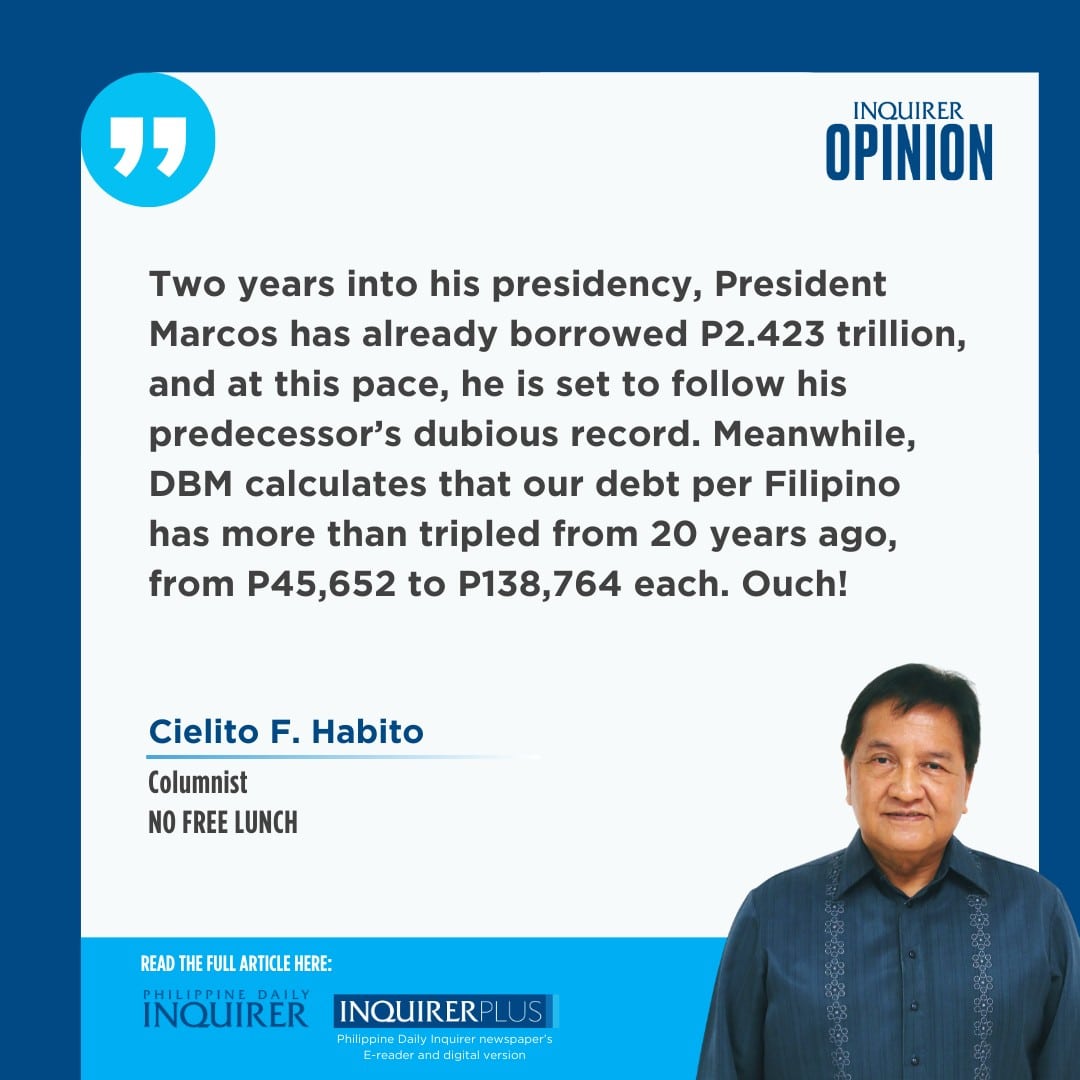All our presidents’ debts
Did you know that exactly 20 years ago, practically all or 99.5 percent of taxes our government collected went to servicing its debt? Imagine a heavily indebted wage worker who, on payday, only gets to keep a meager 50 centavos out of every P100 in the pay envelope, and must hand over nearly everything else to the neighborhood “5-6” lender.
This was literally our situation in 2004, as recorded in data anyone can access from the Department of Budget and Management (DBM) website; all the fiscal data since 1983 are there.
In 2004, our tax revenues were P605 billion, while debt service payments nearly equaled that at P601.7 billion (P260.9 billion for interest payments and P340.8 billion for the principal amortization). So how did the government support its operations? Literally, it ran on more borrowed money, plus some P101.3 billion of non-tax earnings from fees collected by various offices, and P420 million in privatization proceeds. Those fees include what we pay for passports, drivers’ licenses, and car registration, among others. In our wage worker analogy, the daily needs are financed with even more borrowing, some income from a little sideline, and proceeds from selling a few possessions. We were, literally, in a fiscal crisis.
It was that crisis in the middle of the Arroyo administration that forced on us the bitter pill of a value-added tax (VAT) hike from 10 to 12 percent in 2006. By 2007, debt service only equaled 65.4 percent of tax revenues, down from 99.5 percent in 2004 and 97.7 percent in 2006. It fell further to 53.8 percent in 2008, but as the global financial crisis flattened the economy and shrank tax collections, the ratio again rose to 79.4 percent in 2009, and further to 85.9 percent by the time President Gloria Macapagal Arroyo stepped down in 2010.
President Benigno C. Aquino III’s economic managers brought the ratio down to 36 percent, the lowest since President Fidel V. Ramos got it down to 26.6 percent in 1997.
How have our presidents managed the country’s debt?
President Ferdinand Marcos Sr. left behind a total outstanding debt of P395 billion, and a consolidated public sector deficit (CPSD—the excess of all public sector spending over all government tax and non-tax revenues) of P36.2 billion, colossal by 1986 standards. It was equivalent to 5.7 percent of GDP, nearly twice the 3-percent threshold generally considered rule of thumb for a “safe” and sustainable level of deficit.
President Cory Aquino’s fiscal managers brought the deficit down to 2 percent of GDP by 1987, and further down to 1.8 percent, with a debt of P870 billion when she passed on the presidency to Ramos in 1992. The years 1994 to 1997 saw a surplus in our national government budget, with revenues exceeding 17 percent of GDP for four years (with a record high of 17.9 percent), a feat yet to be matched by any of his successors. He left the government with solid finances and a total outstanding debt of P1.496 trillion.
President Joseph Estrada’s aborted term in 1998-2001 saw GDP growing annually at an average of 3.5 percent, while public debt grew the fastest across all seven presidencies, at an average annual growth rate of 16.9 percent, nearly five times the growth in national income. The CPSD averaged 4.6 percent of GDP, again breaching the 3-percent threshold. The public debt stood at P2.385 trillion in 2001 when Arroyo took over, whose government continued to breach the 3-percent deficit limits, leading us to the fiscal crisis that forced the VAT hike in 2006. This helped her achieve a nearly balanced budget in 2007-2008, only to turn for the worse again with the global economic slowdown. When the younger Aquino took over in 2010, the public debt stood at P4.718 trillion.
It was Aquino who managed the public debt best. The debt grew slowest under his watch, at an average annual rate of 4.4 percent, and yet the economy grew the fastest across seven presidencies from his mother to the present, with a 6.2-percent average annual GDP growth. He remains the only president who had kept the public debt from growing faster than GDP, a critical condition for debt sustainability.
His successor President Rodrigo Duterte, however, reversed it all by borrowing more than all his predecessors combined, adding P7.329 trillion to the P6.09 trillion accumulated debt he inherited, and allowing debt to grow nearly four times faster than GDP did. While COVID-19 expenses (including the wayward Pharmally funds) largely explain the extraordinary surge in 2020, his government kept allowing the CPSD to remain well over the threshold at 8.6 and 7.3 percent of GDP in 2021 and 2022, beyond the COVID-19 emergency.
Two years into his presidency, President Marcos has already borrowed P2.423 trillion, and at this pace, he is set to follow his predecessor’s dubious record. Meanwhile, DBM calculates that our debt per Filipino has more than tripled from 20 years ago, from P45,652 to P138,764 each. Ouch!
—————-
cielito.habito@gmail.com






















